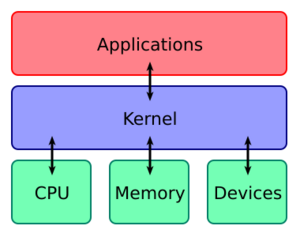Kernel (computer science) facts for kids
Imagine your computer's operating system as a big team of helpers. The kernel is like the team leader! It's the most important part of your computer's operating system. It helps manage everything, especially the computer's parts like its brain (the CPU) and its memory.
You never directly talk to the kernel. It works quietly behind the scenes. You might only see its messages if something goes wrong.
There are different types of kernels:
- A microkernel is very small. It only handles the most basic tasks.
- A monolithic kernel is bigger. It includes many programs called device drivers.
- There are also hybrid kernels and exokernels.
What a Kernel Does
The kernel is the core of your computer's operating system. Think of it as the main program that controls all other programs.
When your computer starts up, the kernel gets to work. It checks the computer's memory and gets everything ready. It's in charge of giving out and taking back memory space. This allows all your software to run smoothly.
The kernel also helps programs use your computer's hardware. For example, if a game needs to use your network card or hard drive, it asks the kernel. The kernel then sends these requests to special programs called device drivers. These drivers know how to talk to the hardware.
The kernel also manages your file system. It helps the CPU switch between different tasks. This is how your computer can do many things at once, like playing music and browsing the internet. The kernel also makes sure that one program doesn't mess up another. It stops programs from using memory they shouldn't. It also limits how much of the CPU's time a program can use.
It truly is the heart of your computer's operating system!
Microkernels vs. Monolithic Kernels
Most operating systems today use monolithic kernels. For example, in Linux, many device drivers are part of the kernel. When your computer needs a device, its driver is loaded. This makes the kernel bigger.
Monolithic kernels can sometimes cause problems. If a driver has a bug, it can make the whole computer stop working. This is because the faulty driver is part of the kernel itself. It can bypass the safety rules that usually protect other programs. If too many devices are connected, the kernel might even run out of memory. This can make your computer very slow or crash.
Microkernels try to solve these problems. In a microkernel system, the kernel only handles the most important jobs. These include managing memory and the CPU. Other functions, like drivers, are kept outside the kernel.
This means if a driver goes wrong, the kernel can simply restart it. It's less likely to crash your whole computer. Think of it like a faulty web browser. If your browser crashes, your whole computer doesn't usually crash. The same idea applies to drivers in a microkernel system.
However, creating operating systems with microkernels is very hard. Because of this, they are not as common. Some examples of microkernel operating systems are Minix and QNX.
See also
 In Spanish: Núcleo (informática) para niños
In Spanish: Núcleo (informática) para niños


